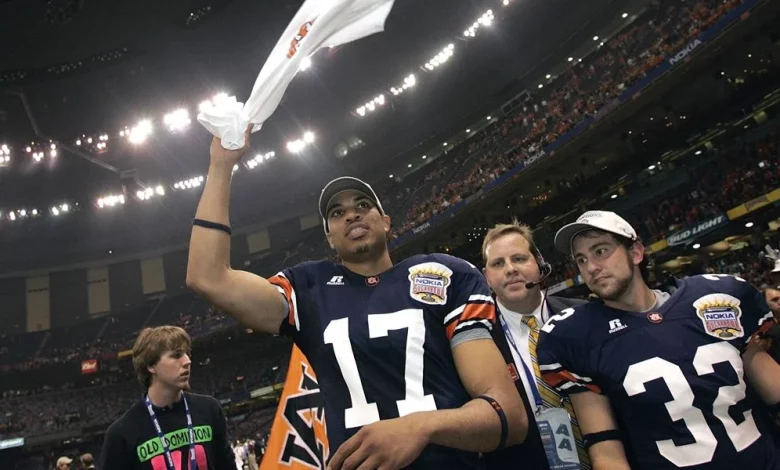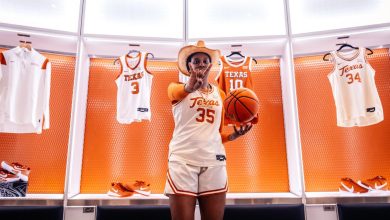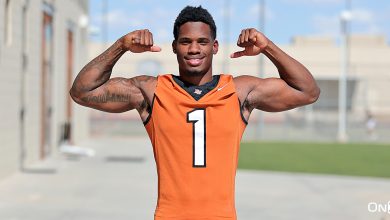The history of Auburn’s apparel partners as Nike era arrives

Auburn University’s football program is steeped in history, tradition, and success. The iconic orange and blue, the powerful “War Eagle” chant, and the boisterous atmosphere of Jordan-Hare Stadium all contribute to the culture that defines Auburn football. But behind the scenes, there’s an often-overlooked part of the Auburn brand that plays a crucial role in shaping the visual identity of the team: the apparel partnership. Over the years, Auburn has seen a shifting array of corporate partners and changing jerseys, designs, and branding. In 2023, the arrival of the Nike partnership marks a significant new chapter in the evolution of Auburn football apparel. But before we dive into this momentous new era, let’s take a look back at the history of Auburn’s apparel partnerships.
In the early days of Auburn football, uniforms were simple and far removed from the flashy, high-tech designs we see today. The first iteration of Auburn’s football uniform was rudimentary, reflecting the nascent state of college football itself. Players wore woolen sweaters, knickers, and simple leather helmets. The Auburn colors were not yet settled either, but the team’s early gear leaned towards combinations of navy, white, and occasionally orange.
Auburn’s uniforms evolved over the next few decades, with changes that reflected not only the program’s growth but also the increased commercialization of the sport. By the time the 20th century rolled around, Auburn’s uniforms had shifted to adopt a more modern look. The colors orange and navy blue had become the dominant identifiers, and the classic Auburn stripes—often found on the sleeves and pants—had begun to make their first appearances.
The post-World War II era marked a significant transition for college football uniforms, as the sport began to take on a more commercialized approach. As college football grew into a national spectacle in the 1950s and 1960s, apparel companies began to see the sport as a new frontier for marketing and brand recognition. Major corporations such as Adidas, Nike, and Puma soon recognized the enormous potential of tying their brands to high-profile athletic programs, and their competition for market dominance began to shape the evolution of college sports uniforms.
For Auburn, the shift to modern, mass-manufactured uniforms and high-tech apparel coincided with the rise of football as a commercial entity. In the 1970s and 1980s, Auburn’s football uniforms were modernized, with new materials and construction methods that made the gear lighter, more durable, and more functional for athletes.
During this period, Auburn continued to rely on various suppliers for its uniforms, with the most notable being Russell Athletic, a company that became synonymous with college football apparel. Russell was a pioneering force in college athletics, supplying uniforms and apparel for several powerhouse programs in the Southeastern Conference (SEC) and beyond. The partnership with Russell was emblematic of Auburn’s position in the college football world at the time—competitive, but still carving out a consistent brand identity on the national stage.
The 1990s marked a pivotal decade in the history of Auburn’s football uniforms. While the 1980s had seen steady growth for Auburn as a football program, the 1990s ushered in a new era where the uniform itself began to carry more significance as a part of the overall brand identity. The 1990s also witnessed the emergence of Nike as the dominant player in the athletic apparel space.
In 1992, Nike, which had already established a dominant presence in basketball and track and field, began making a move into football, specifically college football. Their partnership with the University of Oregon in 1994 would go on to become a groundbreaking collaboration, signaling the dawn of the “Nike era” in college athletics. However, it was not until the mid-1990s that Auburn would begin to explore a partnership with Nike.
Auburn’s eventual move to Nike in 1996 was a landmark moment in the history of the program’s apparel. As Nike’s design aesthetic was revolutionary compared to the more traditional styles of the past, the collaboration brought about significant changes to the look and feel of Auburn’s football uniforms. Nike’s technical fabrics, breathable materials, and sleek designs quickly became a hit in the college football world, and Auburn was no exception. In 1996, Auburn debuted its new Nike uniforms in a game that showcased a cleaner, more modern look, which was widely received by fans and players alike. The uniform also marked the beginning of Auburn’s distinctive branding with a well-defined “A” logo and a streamlined aesthetic that was unlike anything the program had worn before.
With the Nike partnership, Auburn’s football program was now linked with one of the world’s most recognizable sports brands. As Nike continued to dominate the apparel landscape, Auburn was able to tap into a wealth of resources, from high-tech uniform designs to cutting-edge equipment for players. This move also positioned Auburn on a new trajectory in terms of national brand recognition, aligning them with an iconic global brand that embodied innovation, style, and excellence.
In the 2000s, Auburn’s relationship with Nike deepened. By this time, Nike had established itself as a dominant force in college football, outfitting numerous high-profile programs across the country. Auburn remained one of Nike’s key partners, and the uniforms during this period became synonymous with the program’s athletic success. The 2004 season, in particular, was a banner year for both Auburn football and Nike. The Tigers, under head coach Tommy Tuberville, went undefeated and were denied a spot in the BCS National Championship Game, leading to an ongoing debate about the playoff system. During this time, Auburn’s Nike uniforms—especially the bold, new helmet designs—became iconic and helped cement the school’s national identity.
The early 2000s saw Auburn’s football program consistently ranked among the top 15 in the nation, and Nike’s innovative designs only enhanced the program’s visual appeal. Auburn also benefited from Nike’s cutting-edge gear, which included shoes, gloves, and other equipment that helped elevate the team’s performance. The school’s gameday uniforms, in particular, became synonymous with the team’s on-field success. Nike continued to provide new iterations of the Auburn uniform, keeping the look fresh and modern while still maintaining a sense of tradition.
The 2010s proved to be a period of great highs and deep lows for Auburn football. The program had a resurgence in the early part of the decade, with the Tigers winning the SEC Championship and making it to the 2010 BCS National Championship Game. During this time, Auburn’s partnership with Nike remained strong, with the Tigers wearing some of the most technologically advanced and visually striking uniforms in college football.
However, the second half of the decade saw Auburn experience a dip in performance, with fluctuating results under head coach Gus Malzahn. Despite these challenges, the Nike partnership remained stable. Auburn continued to wear Nike’s modern, performance-driven uniforms, which were celebrated for their durability, comfort, and aesthetic appeal. But the football program’s struggles led to a questioning of whether Auburn’s consistency on the field matched the innovation of its apparel on the sidelines.
Auburn’s Nike gear during the 2010s also became a reflection of the larger cultural shift happening in college athletics. College football players were increasingly becoming influencers in their own right, and the uniforms they wore became just as important as the games they played in. Auburn’s Nike uniforms, with their sleek designs and performance features, fit perfectly into this new era of college football.
In 2018, Auburn football made a notable switch in its apparel partnership. After years of working with Nike, Auburn signed a lucrative deal with Under Armour, marking a shift in its branding strategy. Under Armour had made waves in the athletic apparel world, and the company was eager to build on its success by partnering with high-profile college football programs.
This partnership led to some exciting moments, with Under Armour offering Auburn innovative designs and cutting-edge technology for uniforms and gear. However, the relationship between Auburn and Under Armour was not without its issues. Fans often expressed mixed feelings about the design choices and quality of the Under Armour uniforms, citing that they lacked the same sleek, iconic aesthetic that Nike had brought to the program.
Despite some promising moments, the partnership with Under Armour never quite reached the heights of the Nike era. By 2023, Auburn and Under Armour reached a mutual decision to part ways, marking the end of the Tigers’ brief but eventful relationship with the brand.
In 2023, Auburn made headlines once again by announcing its return to Nike as its exclusive apparel partner. This new deal, which was finalized after a year of discussions, marks a historic moment for Auburn football. Nike’s return signifies the revival of the brand that was so closely associated with Auburn’s success in the 1990s and 2000s.
Auburn’s return to Nike is a signal that the program is ready to embrace a new chapter. The Tigers will wear new, technologically advanced Nike uniforms designed for both performance and style. As a part of the agreement, Auburn’s football players will also be outfitted with the latest training gear and equipment, all designed by Nike’s state-of-the-art technology.
The Nike Era of Auburn football is being framed as a return to greatness. As the program builds under head coach Hugh Freeze, the new uniforms will serve as a symbol of the fresh direction and renewed optimism surrounding the Tigers. The dynamic designs and advanced fabrics that have become synonymous with Nike gear will help elevate Auburn’s visual identity as it continues to compete in one of the toughest conferences in college football.
: Full Circle for Auburn Football
Auburn University’s football program has gone through many changes over the decades, but one constant has been the evolution of the uniforms that represent the team. From simple woolen sweaters to the sleek, high-performance gear of today, Auburn’s apparel history is intertwined with the rise of college football and the changing landscape of athletic performance technology. With the return of Nike, Auburn enters a new era that blends tradition with innovation, and the Tigers look poised to embrace the future while honoring the legacy of the past.
In a way, Auburn’s partnership with Nike comes full circle. As the team looks to build on the success of the past, it does so with a renewed sense of identity and pride—both on the field and in the uniforms they wear. The Nike Era at Auburn football is just beginning, and with it comes a new chapter in the program’s storied history.









